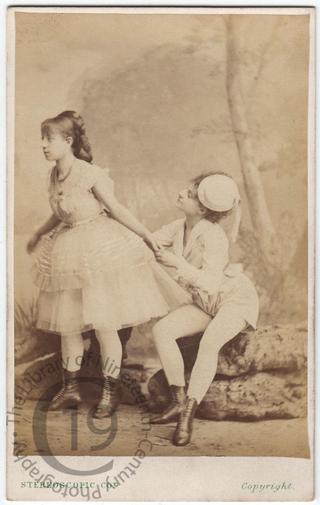
Sarah Wright and Laura Gerrish
A carte-de-visite portrait of Sarah Wright (on the left), and Laura Gerrish (on the right), two of the members of Amelia Newman's Colonna Troupe, early English cancan dancers who caused a sensation in the late 1860s and 1870s.
Sarah Wright's flexibility and gay abandon earned her the soubriquet Wiry Sal. When the troupe appeared at the Alhambra in Leicester Square in 1870, the police intervened on account of Sarah's high kicks and the music hall subsequently lost its dance licence. An American reviewer writing for the Cincinnati Commercial in 1877 described her as 'a small woman, with a childish face, rather tawny skin, to judge by her face, and small arms, yellow hair, that is either very wild naturally or cultivated to be, bright, flashing eyes, a small bust and body, rather thin and wiry then otherwise, and such legs! They are large, muscular members, that throw out the strong lines of muscle with every motion. Her dancing is wild, and decidedly weird; it is of the fantastic and eminently muscular school. She flashes about the stage like lightning, leasing the fastest music. She whirls like a dervish, until, with the momentum that she acquires as she comes down the stage, it seems impossible that she should keep from dashing down into the orchestra. At times she throws her legs up until her toes are far above her head. She can stand on one leg and shoulder the other as a soldier does his musket. Her assistants in the dance, which is of the can-can order, are all well trained and fine-limbed women. Their dancing last night was greatly applauded, and Sara’s exertions, which threw the audience into a sympathetic perspiration, were cheered wildly to the encore.’
Photographed by the London Stereoscopic and Photographic Company.
Code: 126477




